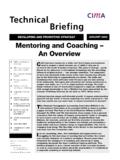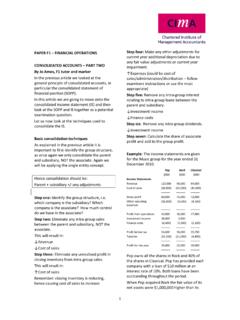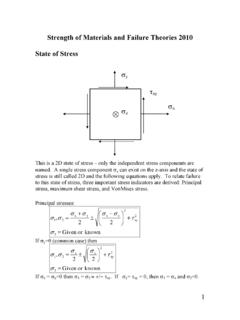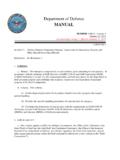Transcription of February 2019 Strategic Case Study Examination Pre-seen ...
1 February 2019 Strategic Case Study Examination Pre-seen material Contents Page Wearable Technology - Overview 3. The wearable fitness and activity tracker market 3. Key drivers of growth in the wearable fitness and activity tracker market 4. Latest development in the market 4. The background and history of Vita 5. Product launch timeline and Sales and Revenue graphs 6. Technology 7. Vita's products and services 8. Examples of visual displays on the Vita tracking devices 10. The manufacturing and sales processes 11. Competitive environment 12. Summary of key competitors 12. Vita's Market share graph 13. Extracts from Vita's Integrated Report Mission/ Vision/ Value Creation 14. Extracts from Vita's Integrated Report Stakeholder Engagement 15. Extracts from Vita's Integrated Report Risk Register 16. Senior Leadership Team 17.
2 Extract from Vita's Annual Report 2018 - Financials 18. Exhibits 21. CIMA 2018. No reproduction without prior consent. 1. Vita You are a Senior Finance Manager at Vita, a consumer electronics company. Vita designs and sells wireless-enabled wearable fitness and activity tracker devices that measure a wide range of personal metrics related to fitness and activity. Vita's headquarters are located in Newland, a prosperous northern European country, where a significant proportion of the population take an active interest in sport and a wide range of health and fitness activities. You report directly to the Chief Finance Officer of Vita and advise on special projects and Strategic matters. Newland's currency is the N$. CIMA 2018. No reproduction without prior consent. 2. Wearable technology - overview Wearable technology is a term used for electronics that can be worn on the body , either as an accessory, or as part of material used in clothing.
3 There are many types of wearable technology. For example: wrist-based fitness and activity trackers, smartwatches, smart shoes and clothing and virtual reality (VR) headsets. One of the major features of wearable technology is its ability to connect to the internet, enabling data to be exchanged between the device and a network, to enable detailed data analysis. The growing popularity of mobile networks has been one of the most important factors in the development of wearable technology. The following case material focuses on the wrist-based fitness and activity tracker segment of the wearable technology market. The wearable fitness and activity tracker market Wearable fitness and activity trackers are wireless-enabled devices that monitor and record a person's fitness and activity. They are designed to monitor and track activity-related metrics such as the number of steps taken, distance walked or run, calories consumed, active minutes and, in some devices, heart rate and sleep quality.
4 Military forces, medical professionals and some businesses (such as security services), have been using wearable technology for decades, but the private consumer market has only recently taken off, largely through the success of wearable fitness and activity trackers. The first commercially available wearable devices designed for private consumers, developed in the early 2000s, were little more than step counters (also known as pedometers). However, the last 10 years has seen a phenomenal rise in the technical accuracy, usability, affordability and popularity of fitness and activity trackers. Most fitness and activity trackers synchronise (sync). activity data to applications (apps) on smart devices, or data can be synced to a website on a computer. The apps and websites then present the users with their activity data in a range of graphical formats.
5 They are exclusively designed to give users an insight into their overall activity and fitness progress. The apps and websites developed by the manufacturers of fitness and activity trackers also offer a social dimension to sharing fitness information with the tracker wearing community. These apps and websites often offer a community page, where users can challenge themselves and compete against other users or friends who use the same device. Much of the appeal of fitness and activity trackers, which makes them effective tools for increasing personal fitness, comes from them making exercise fun and challenging. Use of an app can serve as a means of identification with a fitness community, where users can also choose to share their progress, pictures and achievements with that community. CIMA 2018.
6 No reproduction without prior consent. 3. It is estimated that, as at the end of 2018, there were over 150 million active users of fitness and activity trackers throughout the world. An active user is defined as a registered user of a wearable fitness tracker device who, within the three months prior to the date of measurement, has an active subscription which has been synced with the health and fitness tracker, or has logged at least 100 steps with a health and fitness tracker . Key drivers of growth in the fitness and activity tracker market There are a number of factors that have contributed to the growth of the fitness and activity tracker market in the last ten years. Firstly, the increasing use of smartphone-based fitness tracking apps is a key driver in the wearable fitness and activity tracker market.
7 These fitness tracking apps offer enhanced levels of functionality, with designs and features that can help an individual to stay fit. Due to easy accessibility and low cost, consumers are becoming more inclined towards using these apps, in conjunction with fitness and activity tracking devices. Moreover, the fitness tracking apps are supported by all major smartphone operating systems, such as iOS and Android. Secondly, in the last few years, many organisations have been conducting fitness and health awareness and management programmes, to reduce the costs in the health care system. For instance, non-profit organisations in Europe and North America have conducted various programmes to increase the awareness about health and fitness issues, such as the benefits of proper diet and exercise. This increasing awareness among consumers has boosted the demand of fitness and activity trackers.
8 Thirdly, the technology used in the latest fitness and activity trackers is far more accurate and sophisticated than the earliest models. Designs have become more lightweight and user friendly and are now seen as a fashion accessory for many users. The range of designs available and the wide range of functionality has meant that fitness and activity trackers have a wide demographic appeal and are used by males and females from 8 to 80 plus years. Latest development in the fitness and activity tracker market The latest development in the fitness and activity tracker market has been the development of the smartwatch. Smartwatches connect to the user's phone using various wireless technologies, such as Bluetooth, Wi-Fi and GPS, and serve as a front-end for a remote system such as a smartphone. A smartwatch allows users to read and respond to texts, see emails, use a range of wrist-based apps (often extensions of the smartphone apps themselves) and provide notifications from social media apps.
9 Many of the latest smartwatches developed since 2015 now include fitness tracking technology as standard. Exploiting the hybrid watch and fashion accessories smartwatch market is the latest major opportunity in the fitness and activity tracker market. More advanced smartwatches have also recently been designed to measure and monitor specific sporting activities, such as running, cycling, swimming and golf. In 2018, global unit sales of smartwatches exceeded unit sales of fitness and activity trackers for the first time. CIMA 2018. No reproduction without prior consent. 4. The background and history of Vita Vita was formed in 2011 by two friends, Rhea Turner and Gal Yaluz, who both studied Information Technology Management at the same university in the economically developed country of Newland. Rhea and Gal ran together as members of the university's distance running club and often talked of turning their interest in fitness into a business.
10 It was during one of many long runs together that they had the idea of developing wearable fitness and activity tracking technology that went further than the basic pedometers they had been using. They considered how useful it would be to have detailed information about their runs collected in an unobtrusive manner. Vita was founded to develop wearable devices that could offer that functionality. Vita was initially financed by a low interest, new technology grant offered by the Newland government, and money borrowed from friends and family. Vita's first fitness and activity tracker, the Liber', was launched in 2011 and took the form of a small clip-on tracker showing steps, distance, calories, floors climbed and the time. Rhea and Gal sourced their products from two inexpensive contract manufacturers in Asia, which were also relatively new organisations.















